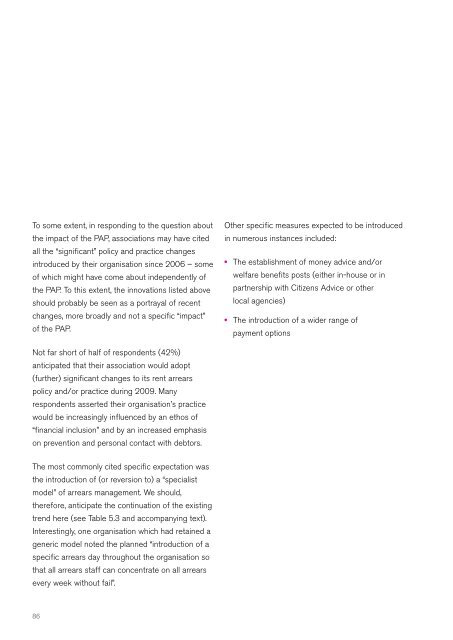Rent arrears management practices in the housing association sector
Rent arrears management practices in the housing association sector
Rent arrears management practices in the housing association sector
You also want an ePaper? Increase the reach of your titles
YUMPU automatically turns print PDFs into web optimized ePapers that Google loves.
To some extent, <strong>in</strong> respond<strong>in</strong>g to <strong>the</strong> question about<br />
<strong>the</strong> impact of <strong>the</strong> PAP, <strong>association</strong>s may have cited<br />
all <strong>the</strong> “significant” policy and practice changes<br />
<strong>in</strong>troduced by <strong>the</strong>ir organisation s<strong>in</strong>ce 2006 – some<br />
of which might have come about <strong>in</strong>dependently of<br />
<strong>the</strong> PAP . To this extent, <strong>the</strong> <strong>in</strong>novations listed above<br />
should probably be seen as a portrayal of recent<br />
changes, more broadly and not a specific “impact”<br />
of <strong>the</strong> PAP .<br />
Not far short of half of respondents (42%)<br />
anticipated that <strong>the</strong>ir <strong>association</strong> would adopt<br />
(fur<strong>the</strong>r) significant changes to its rent <strong>arrears</strong><br />
policy and/or practice dur<strong>in</strong>g 2009 . Many<br />
respondents asserted <strong>the</strong>ir organisation’s practice<br />
would be <strong>in</strong>creas<strong>in</strong>gly <strong>in</strong>fluenced by an ethos of<br />
“f<strong>in</strong>ancial <strong>in</strong>clusion” and by an <strong>in</strong>creased emphasis<br />
on prevention and personal contact with debtors .<br />
The most commonly cited specific expectation was<br />
<strong>the</strong> <strong>in</strong>troduction of (or reversion to) a “specialist<br />
model” of <strong>arrears</strong> <strong>management</strong> . We should,<br />
<strong>the</strong>refore, anticipate <strong>the</strong> cont<strong>in</strong>uation of <strong>the</strong> exist<strong>in</strong>g<br />
trend here (see Table 5 .3 and accompany<strong>in</strong>g text) .<br />
Interest<strong>in</strong>gly, one organisation which had reta<strong>in</strong>ed a<br />
generic model noted <strong>the</strong> planned “<strong>in</strong>troduction of a<br />
specific <strong>arrears</strong> day throughout <strong>the</strong> organisation so<br />
that all <strong>arrears</strong> staff can concentrate on all <strong>arrears</strong><br />
every week without fail” .<br />
86<br />
O<strong>the</strong>r specific measures expected to be <strong>in</strong>troduced<br />
<strong>in</strong> numerous <strong>in</strong>stances <strong>in</strong>cluded:<br />
• The establishment of money advice and/or<br />
welfare benefits posts (ei<strong>the</strong>r <strong>in</strong>-house or <strong>in</strong><br />
partnership with Citizens Advice or o<strong>the</strong>r<br />
local agencies)<br />
• The <strong>in</strong>troduction of a wider range of<br />
payment options




